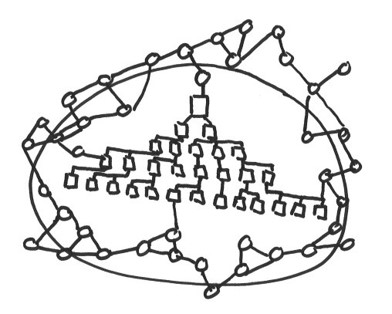Oday Kamal observes that ‘The tension between hierarchy and networks is fundamental in charting the course of the future of work.’ And then asks several questions: ‘How can beneficial networks be nurtured in organizations? Where does a legacy hierarchical structure and a nascent network intersect and support each other? How can we determine if our organizations are choking the life out of potentially beneficial networks before they can really make a positive impact?’
He doesn’t answer these questions but they’re relevant to an introductory session I’m running this week on organizational hierarchies and networks and how work gets done, and I’ve been ruminating on them.
We seem to be moving towards the idea that networked structures are ‘a good thing’ in an age where hierarchies and ‘power over’ organizations seem to have had their day.
Amy Edmundson and Michael Lee describe hierarchies as being based on two principles a) A hierarchy of authority where individuals report to managers who have the authority to direct and prioritize the execution and allocation of tasks, review performance, and in many cases, hire and fire; b) A hierarchy of accountability—that is, work accountabilities roll up from direct reports to managers who hold ultimate accountability for the work of all those below in the organization chart.
They imply, as does Deloitte in the 2017 Human Capital Trends, that these organizational hierarchies are not fit for our digitized, networked age and that a more appropriate design is one that ‘radically decentralizes authority in a formal and systematic way throughout the organization,’
Networks fall into this category. Jessica Lipnack and Jeff Stamps describe them as configurations ‘where independent people and groups act as independent nodes, link across boundaries, to work together for a common purpose; it has multiple leaders, lots of voluntary links and interacting levels.’ They’re based on the principles that
- Authority is not from a hierarchy but from individual’s recognized knowledge and skill
- Links are between people and teams across conventional boundaries (e.g. departments and geographies)
- Members and structures adapt to changing circumstances
- Management has a sense of mutual responsibility
- People explore ways to work effectively
- Teams are readjusted or disbanded needed
Can the very differently principled networks and hierarchies co-exist in one organization and would this resolve the tensions Oday Kamal observes?
John Kotter suggests so. In his article Hierarchy and Network: Two Structures, One Organization, he tells us that:
The successful organization of the future will have two organizational structures: a Hierarchy, and a more teaming, egalitarian, and adaptive Network. Both are designed and purposive. While the Hierarchy is as important as it has always been for optimizing work, the Network is where big change happens. … My idea of the Network is a system of teams with representatives from all divisions and all levels, who leave formal titles at the door to participate in a decidedly anti-hierarchical forum. (See also his HBR article Accelerate)
But, not obvious in either the principles or the discussions of formal hierarchies and networks are the informal networks that exist within them – of friendship, influence, knowledge, etc. (Unless this is what Kamal means by ‘beneficial network’).
Organizational network mapping, of the type Rob Cross does, clearly shows us that informal networks of social connection and interaction are strong in all types of organizations and they can be very powerful influencers – beneficial or not – of individual, team and organizational performance. (Watch the TED talk on the hidden influence of social networks.)
There may be tensions between hierarchies and networks, and they may be resolvable by having both present in one organization but only if the strength of the informal social network ties are identified and factored into the design thinking. (Here’s a helpful Oxfam blog on getting started in social network mapping).
The informal, social networks are what make organizations work and they can’t be designed. How can knowing more about them help us decide how to configure the formal hierarchies and networks either as independent forms or as integral forms? Let me know.
Image Jakob Wolman


One thought on “Hierarchies and networks”
Comments are closed.